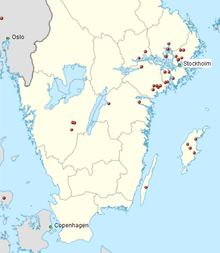Varangian runestones
The Varangian runestones are runestones in Scandinavia that talk of eastward voyages such as the Gardarike runestones, Greece Runestones, Italy Runestones, and inscriptions left by the Varangian Guard. Other runestones that deal with Varangian expeditions include the Serkland Runestones (dealing with expeditions to the Middle East) and the Ingvar Runestones (erected in honor or memory of those who travelled to the Caspian Sea with Ingvar the Far-Travelled).[1] There is also a separate article for the Baltic expeditions runestones.

In addition, there were also voyages to Western Europe mentioned on runestones that are treated in the articles Viking Runestones, England Runestones and Hakon Jarl Runestones. Almost all of the Varangian runestones are found in modern day Sweden.
Most of the runestones were raised during the Christianization of the 11th century when the making of runestones was fashionable, but notably the Kälvesten Runestone Ög 8 was made in the 9th century when the Varangians played a central role in what would become Russia and Ukraine. This vast area was a rich source of pelts, hides and people, and it was an important component in the contemporary Swedish economy.[2]
All of the stones were engraved in Old Norse with the Younger Futhark.
Sources
- Jones, Gwyn (1968). A History of the Vikings. New York: Oxford University Press.
- Jansson, Sven B. F. (1980). Runstenar. STF, Stockholm. ISBN 91-7156-015-7
- Jansson, Sven B. F (1987). Runes in Sweden. Stockholm, Gidlund. ISBN 91-7844-067-X
- Peterson, Lena (2002). Nordisk Runnamnslexikon. Swedish Institute for Linguistics and Heritage (Institutet för språk och folkminnen).
- Pritsak, Omeljan (1981). The Origin of Rus': Old Scandinavian Sources Other than the Sagas. Cambridge, Mass.: Harvard University Press. ISBN 0-674-64465-4.
Notes
- e.g., Jones 267.
- Jansson 1980:31